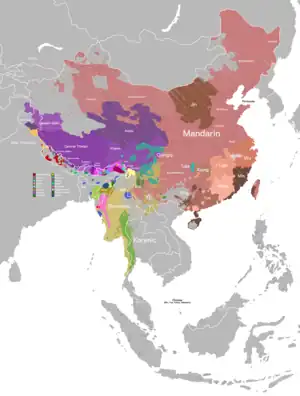| Kaike | |
|---|---|
| Magar Kaike | |
| Native to | Nepal |
| Ethnicity | 2,000 (2011)[1] |
Native speakers | 50 (2011 census)[1] |
| Language codes | |
| ISO 639-3 | kzq |
| Glottolog | kaik1246 |
| ELP | Kaike |
Magar Kaike is a Sino-Tibetan language of Nepal. Ethnologue classifies it as a West Bodish language.
Distribution
Kaike is spoken in Shahartara, Tupatara, Tarakot, and Belawa villages of Sahartara VDC, Dolpa District, Karnali Province, Nepal (Ethnologue).
Linguistic contact
Honda (2008)[2] notes that Kaike shares many words with Tamangic, but is not part of Tamangic proper. It is also in contact with Tichurong, a divergent Tibetic lect spoken near the Kaike-speaking areas.[3] Zemp (2023) discusses the heavy influence of Tichurong on Kaike, but notes that Kaike has a Tamangic base.[4]
Lexicon
Honda (2008) lists the following Kaike words.
| No. | Gloss | Kaike |
|---|---|---|
| 1 | gold | mar |
| 2 | cow | mi |
| 3 | blood | ka: |
| 4 | black | myān- |
| 5 | red | lo:- |
| 6 | green | piŋ- |
| 7 | milk cow | ne- |
| 8 | thread | rup |
| 9 | heart | diŋ |
| 10 | (be) dry | khār- |
| 11 | snow | liŋ |
| 12 | hen | kā: |
| 13 | egg | kā:-pum |
| 14 | lay eggs | phum- |
| 15 | excrement | khyi |
| 16 | one | ti: |
| 17 | nose | nā |
| 18 | to rest | nā- |
| 19 | nasal mucus | nap |
| 20 | seven | ne |
| 21 | thin | bā- |
| 22 | eye | mi: |
| 23 | name | min |
| 24 | fire | me |
| 25 | tongue | lai |
| 26 | month | lā |
| 27 | ladder | li |
| 28 | heavy | li- |
| 29 | break (e.g., firewood) | kyut- |
| 30 | plough, dig | khoə- |
| 31 | borrow/lend | khyi- |
| 32 | field | khye |
| 33 | chest | gu |
| 34 | borrow | ŋan- |
| 35 | nest | cāŋ |
| 36 | bridge | cām |
| 37 | daughter | came |
| 38 | hang, tie | cun- |
| 39 | knead | cyen- |
| 40 | hair | cham |
| 41 | lift | thi- |
| 42 | measure (e.g., length) | kāt- |
| 43 | portion | kāl |
| 44 | burn | ko- |
| 45 | weigh | kot- |
| 46 | shake | khār- |
| 47 | feed | khoə:- |
| 48 | grandfather | khye |
| 49 | suck | ŋup- |
| 50 | cook, put on the stove | cu:- |
| 51 | now | cõ: |
| 52 | count | jyer- |
| 53 | what | tai |
| 54 | receive | tā:- |
| 55 | post, pillar | tā: |
| 56 | spread | tit- |
| 57 | this year | tiriŋ |
| 58 | meet | do:- |
| 59 | need to | toə- |
| 60 | today | tyā |
| 61 | full | nāŋ- |
| 62 | tomorrow | nāpcye |
| 63 | garlic | noə |
| 64 | break (itr.) | noŋ- |
| 65 | fear | nyin- |
| 66 | go | yā |
| 67 | marker of hearsay | ru |
| 68 | village | nām |
| 69 | dog | khyu |
| 70 | fly (insect) | baraŋ |
| 71 | fish | ŋā |
| 72 | foot, leg | le |
| 73 | grind | ra:- |
| 74 | cliff | ra: |
| 75 | four | li |
| 76 | flatten | lep- |
| 77 | see | raŋ- |
| 78 | smile, laugh | rai- |
| 79 | penis | lu |
| 80 | forget | let- |
| 81 | rice | lā |
| 82 | flour | rā:pi |
| 83 | buckwheat | barau: |
References
- 1 2 Kaike at Ethnologue (18th ed., 2015) (subscription required)
- ↑ Honda, Isao. 2008. Some observations on the relationship between Kaike and Tamangic. Nepalese Linguistics 23: 85-116.
- ↑ Honda, Isao. 2018. Preliminary report on Tichyurong Tibetan (Dolpa, Nepal). Proceedings of the 51st International Conference on Sino-Tibetan Languages and Linguistics (2018). Kyoto: Kyoto University.
- ↑ Zemp, Marius. 2023. Tichurong-Tibetic influence in the grammar of Kaike (Nepal). 26th Himalayan Languages Symposium, 4-6 September 2023. Paris: INALCO.
This article is issued from Wikipedia. The text is licensed under Creative Commons - Attribution - Sharealike. Additional terms may apply for the media files.
